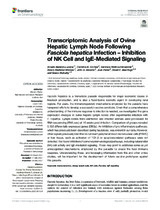Mostrar el registro sencillo del ítem
Transcriptomic Analysis of Ovine Hepatic Lymph Node Following Fasciola hepatica Infection – Inhibition of NK Cell and IgE-Mediated Signaling
| dc.contributor.author | Naranjo-Lucena, Amalia | |
| dc.contributor.author | Correia, Carolina N. | |
| dc.contributor.author | Molina-Hernández, Verónica | |
| dc.contributor.author | Martínez Moreno, Álvaro | |
| dc.contributor.author | Browne, J.A. | |
| dc.contributor.author | Pérez, José | |
| dc.contributor.author | MacHugh, David E. | |
| dc.contributor.author | Mulcahy, Grace | |
| dc.date.accessioned | 2024-02-09T11:21:28Z | |
| dc.date.available | 2024-02-09T11:21:28Z | |
| dc.date.issued | 2021 | |
| dc.identifier.uri | http://hdl.handle.net/10396/27364 | |
| dc.description.abstract | Fasciola hepatica is a trematode parasite responsible for major economic losses in livestock production, and is also a food-borne zoonotic agent in developing rural regions. For years, the immunoregulatory mechanisms employed by the parasite have hampered efforts to develop a successful vaccine candidate. Given that a comprehensive understanding of the immune response to infection is needed, we investigated the gene expression changes in ovine hepatic lymph nodes after experimental infection with F. hepatica. Lymph nodes from uninfected and infected animals were processed for RNA sequencing (RNA-seq) at 16 weeks post-infection. Comparison of groups revealed 5,132 differentially-expressed genes (DEGs). An inhibition of pro-inflammatory pathways, which has previously been described during fasciolosis, was evident in our data. However, other signals previously identified in ruminant peripheral blood mononuclear cells (PBMC) or liver tissue, such as activation of TGF-β or apoptosis-related pathways were not detected. We found inhibition of some key immunological pathways, including natural killer (NK) cell activity and IgE-mediated signaling. These may point to additional some as yet unrecognized mechanisms employed by the parasite to evade the host immune response. Understanding these, and leveraging information from this and other omics studies, will be important for the development of future vaccine prototypes against this parasite. | es_ES |
| dc.format.mimetype | application/pdf | es_ES |
| dc.language.iso | eng | es_ES |
| dc.publisher | Frontiers | es_ES |
| dc.rights | https://creativecommons.org/licenses/by-nc-nd/4.0/ | es_ES |
| dc.source | Naranjo‐Lucena, A., Correia, C. N., Molina-Hernández, V., Martínez-Moreno, Á., Browne, J. A., Pérez, J., MacHugh, D. E., & Mulcahy, G. (2021). Transcriptomic Analysis of Ovine Hepatic Lymph Node Following Fasciola hepatica Infection – Inhibition of NK Cell and IgE-Mediated Signaling. Frontiers In Immunology, 12. https://doi.org/10.3389/fimmu.2021.687579 | es_ES |
| dc.subject | Fasciola | es_ES |
| dc.subject | IgE signalling | es_ES |
| dc.subject | NK cells | es_ES |
| dc.subject | Lymph node | es_ES |
| dc.subject | Sheep | es_ES |
| dc.subject | Transcriptomics | es_ES |
| dc.title | Transcriptomic Analysis of Ovine Hepatic Lymph Node Following Fasciola hepatica Infection – Inhibition of NK Cell and IgE-Mediated Signaling | es_ES |
| dc.type | info:eu-repo/semantics/article | es_ES |
| dc.relation.publisherversion | https://doi.org/10.3389/fimmu.2021.687579 | es_ES |
| dc.relation.projectID | info:eu-repo/grantAgreement/EC/H2020/635408 (PARAGONE) | es_ES |
| dc.rights.accessRights | info:eu-repo/semantics/openAccess | es_ES |

